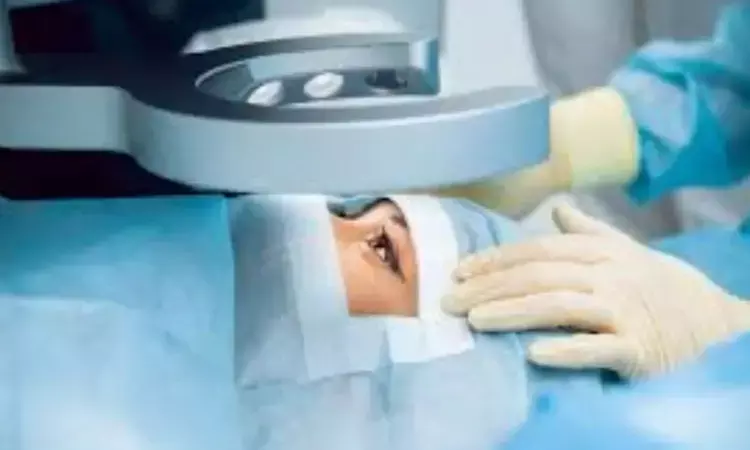- Home
- Medical news & Guidelines
- Anesthesiology
- Cardiology and CTVS
- Critical Care
- Dentistry
- Dermatology
- Diabetes and Endocrinology
- ENT
- Gastroenterology
- Medicine
- Nephrology
- Neurology
- Obstretics-Gynaecology
- Oncology
- Ophthalmology
- Orthopaedics
- Pediatrics-Neonatology
- Psychiatry
- Pulmonology
- Radiology
- Surgery
- Urology
- Laboratory Medicine
- Diet
- Nursing
- Paramedical
- Physiotherapy
- Health news
- Fact Check
- Bone Health Fact Check
- Brain Health Fact Check
- Cancer Related Fact Check
- Child Care Fact Check
- Dental and oral health fact check
- Diabetes and metabolic health fact check
- Diet and Nutrition Fact Check
- Eye and ENT Care Fact Check
- Fitness fact check
- Gut health fact check
- Heart health fact check
- Kidney health fact check
- Medical education fact check
- Men's health fact check
- Respiratory fact check
- Skin and hair care fact check
- Vaccine and Immunization fact check
- Women's health fact check
- AYUSH
- State News
- Andaman and Nicobar Islands
- Andhra Pradesh
- Arunachal Pradesh
- Assam
- Bihar
- Chandigarh
- Chattisgarh
- Dadra and Nagar Haveli
- Daman and Diu
- Delhi
- Goa
- Gujarat
- Haryana
- Himachal Pradesh
- Jammu & Kashmir
- Jharkhand
- Karnataka
- Kerala
- Ladakh
- Lakshadweep
- Madhya Pradesh
- Maharashtra
- Manipur
- Meghalaya
- Mizoram
- Nagaland
- Odisha
- Puducherry
- Punjab
- Rajasthan
- Sikkim
- Tamil Nadu
- Telangana
- Tripura
- Uttar Pradesh
- Uttrakhand
- West Bengal
- Medical Education
- Industry
Migraine History Linked to Persistent Dysphotopsia after Monofocal Lens Implantation, claims study

Dysphotopsia, characterized by the perception of visual disturbances such as glare or halos, is a common concern following cataract surgery with intraocular lens (IOL) implantation. While transient dysphotopsia often resolves spontaneously, persistent dysphotopsia can significantly impact patient satisfaction and quality of life.
Researchers have found in a new study that history of migraine was associated with increased dysphotopsia severity and decreased patient satisfaction following cataract surgery with intraocular lens (IOL) implantation.
The study published in the Canadian Journal Of Ophthalmology was conducted by Maggie J. and colleagues.
Previous studies have explored various factors contributing to dysphotopsia, including IOL design, pupil size, and optical properties. However, the role of neuroadaptation-related risk factors, such as migraine history, remains less understood. Migraine is known to involve neurovascular mechanisms that could influence visual perception and potentially exacerbate dysphotopsia symptoms.
In this retrospective cohort study, conducted at an academic institution and a private practice in Saint Louis, Missouri, researchers aimed to identify neuroadaptation-related risk factors for persistent positive dysphotopsia (>6 months) following monofocal lens implantation. Participants included adults who underwent cataract extraction with monofocal IOL implantation between January 2010 and April 2021. Exclusion criteria comprised dementia, visual pathway damage, and significant pathology causing photopsia.
The key findings of the study were as follows:
• The study included 385 participants (385 eyes), of whom 66 experienced persistent dysphotopsia (58 positive), while 298 had none, and 21 had nonpersistent dysphotopsia.
• Migraine prevalence was higher among individuals with dysphotopsia (21.2%) compared to those without (11.4%).
• History of migraine was associated with an increase in Pseudophakic Dysphotopsia Questionnaire 6 (PDQ-6) score by 2.76 points (p = 0.006).
• Six individuals in each group had Visual Aura Rating Scale (VARS) scores greater than zero.
• The mean VARS score was significantly higher in the dysphotopsia group (0.48) compared to the non-dysphotopsia group (0.14) (p = 0.03).
• Younger age, female sex, history of migraine, and higher VARS score were associated with lower satisfaction levels among participants with dysphotopsia.
The study findings suggest that a history of migraine is associated with increased severity of dysphotopsia and decreased patient satisfaction following monofocal lens implantation. These results underscore the importance of considering migraine history in patient selection and counseling to optimize surgical outcomes and enhance patient satisfaction. Further research with larger sample sizes is warranted to validate these findings and inform personalized approaches to cataract surgery.
Reference:
Xing, M. J., Moulin, T. A., Suresh, T., Gira, J. P., Sheybani, A., & Van Stavern, G. P. (2024). Migraine is a risk factor for pseudophakic positive dysphotopsia following monofocal lens implantation. Canadian Journal of Ophthalmology. Journal Canadien d’ophtalmologie. https://doi.org/10.1016/j.jcjo.2024.02.010
Dr Riya Dave has completed dentistry from Gujarat University in 2022. She is a dentist and accomplished medical and scientific writer known for her commitment to bridging the gap between clinical expertise and accessible healthcare information. She has been actively involved in writing blogs related to health and wellness.
Dr Kamal Kant Kohli-MBBS, DTCD- a chest specialist with more than 30 years of practice and a flair for writing clinical articles, Dr Kamal Kant Kohli joined Medical Dialogues as a Chief Editor of Medical News. Besides writing articles, as an editor, he proofreads and verifies all the medical content published on Medical Dialogues including those coming from journals, studies,medical conferences,guidelines etc. Email: drkohli@medicaldialogues.in. Contact no. 011-43720751


